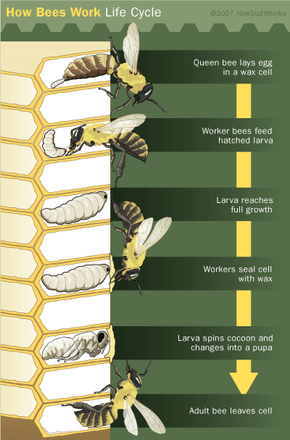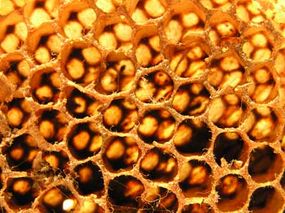Quck answer
Bees are social insects that play a crucial role in pollinating plants and producing honey. They live in colonies, with a queen bee at the center of the hive and worker bees performing various tasks. Bees communicate through dance and pheromones to coordinate their activities. They collect nectar and pollen from flowers and use it to make honey and feed their young. Bees also have a complex system of navigation, using landmarks and the position of the sun to find their way back to the hive. However, bees are facing threats from habitat loss and pesticides, which can have serious consequences for both their survival and the health of our ecosystems.
Wildlife
The Honeycomb and Fertilization Process

Regardless of whether they live individually or in colonies, most bees have a similar approach to mating. In almost every species, the male bee’s only role is to mate with a female. In social species, most male bees lack the necessary structures for making wax or carrying pollen, so they cannot contribute to the daily work that occurs in the hive. In fact, female honeybees usually force surviving males out of the nest before winter or when food becomes scarce.
Typically, a female bee mates with several male bees midair, gathering all the sperm she will require in her lifetime – a few months for a solitary bee, or up to five years for a honeybee. Generally, a collective mating site is where mating occurs, although scientists have not yet discovered how male bees choose a site. In some species, like honeybees, the males die shortly after mating because they leave their endophallus in the female’s body, fatally injuring themselves in the process. In other species, males can mate with multiple females. Since females use sperm from several males to fertilize their eggs, this gives male bees a better chance to father young.
After mating, the female bee either retreats to a shelter for the winter or returns to her nest to lay eggs, depending on her species. Once she lays eggs, the eggs go through the same stages as caterpillars and butterflies do. First, they hatch into larvae. The larvae eat before spinning cocoons and becoming pupae. They then emerge from the cocoons as adults.
Even though the steps are the same, the environment in which the developing bee grows can vary considerably. In solitary bees, the female builds a nest, places food inside, and lays an egg. The food may include a mix of pollen and nectar called bee bread, as well as a form of honey. Exactly how the bee positions her egg and its food varies depending on the bee’s species, as does the construction of the nest itself. Some bees lay only one egg in each nest, while others divide their nests into multiple brood chambers. In nests with multiple chambers, male eggs usually go in the front, allowing young male bees to travel to the mating site before the female bees hatch. Many solitary bees seal their nests after laying eggs and never see their young. Often, these species lay eggs in the fall, and the eggs hatch in the spring, but the mother bees do not survive the winter.

Each cell in a bee hive’s comb can hold honey or a single developing bee.
Image courtesy Stock.xchng
Social bees, on the other hand, have a different approach to raising young. While a female solitary bee lays only a few eggs in her lifetime, a queen honeybee lays thousands. She places one egg into each cell in the brood area of the hive. The queen bee has control over whether she lays male or female eggs, and she lays male eggs in slightly larger cells. If she uses stored sperm to fertilize the egg first, the larva that hatches is female. If she leaves the egg unfertilized, the larva that hatches is male. This means that female bees inherit genes from both their mothers and their fathers, while male bees inherit only genes from their mothers.
Life in the Hive
After hatching, the newborn worker bees assume the responsibility of nurturing the larvae. For the first 48 hours, they feed them royal jelly, then switch to pollen or bee bread. However, the queen bee is an exception. While raising a new queen, the workers continue to feed her royal jelly until she spins her cocoon. The bee larvae undergo multiple molts before spinning cocoons. The cells are then sealed with beeswax plates to protect the brood’s development.
The Life of Female Honeybees
The lifespan of female honeybees depends on their emergence from the cocoon. If they’re born in early spring, they may live for a few weeks and prepare the hive for new bees. However, those born later may survive through winter. Female honeybees start their lives as nurses, taking care of the other bees. As they grow older, they assume different duties, such as cleaning empty cells, producing honey, and foraging for food. In the following section, we’ll examine the bees’ tools for locating and storing food.
FAQ
1. What is the role of bees in pollination?
Bees play a crucial role in pollination. As they gather nectar from flowers, they also collect pollen on their bodies. When they move from one flower to another, they transfer this pollen, which fertilizes the plant and allows it to produce fruit and seeds. Without bees, many plants would not be able to reproduce and the food chain would be disrupted.
2. How do bees communicate with each other?
Bees communicate with each other through a series of dances and pheromones. When a scout bee finds a new source of food, it will return to the hive and perform a “waggle dance” to convey the distance and direction of the food source to other bees. Bees also release pheromones to signal to other bees about the location of food, the presence of danger, and the need to build a new hive.
3. How do bees make honey?
Bees make honey by collecting nectar from flowers and storing it in their honey stomachs. The enzymes in their stomachs break down the nectar into glucose and fructose, which they regurgitate and deposit into honeycomb cells. The bees then fan their wings over the honeycomb to evaporate the moisture, creating a thick, sweet substance that we know as honey.
4. How many bees are in a typical hive?
A typical hive can contain anywhere from 20,000 to 80,000 bees, depending on the time of year and the strength of the colony. The hive is usually composed of one queen bee, hundreds of male drones, and thousands of female worker bees who perform all the tasks necessary to keep the colony running smoothly.
5. Why are bees important for agriculture?
Bees are important for agriculture because they help to pollinate many of the crops that we rely on for food. Without bees, we would see a significant decrease in crop yields and a loss of biodiversity in our agricultural systems. In addition, bees contribute to the production of honey, beeswax, and other valuable products.
6. How do bees defend their hive?
Bees defend their hive by stinging intruders who threaten it. When a bee stings, it releases a pheromone that signals to other bees to attack. The stinger and venom sac are left behind in the skin of the intruder, causing the bee to die. While this may seem like a harsh defense mechanism, it is necessary to protect the hive and ensure the survival of the colony.
7. What are some threats to bee populations?
There are several threats to bee populations, including habitat loss, pesticide use, climate change, and disease. As more land is developed for agriculture and human habitation, bees have fewer places to forage and build their hives. Pesticides can also be harmful to bees, as they can weaken their immune systems and make them more susceptible to disease. Climate change can disrupt the timing of flowering plants, making it more difficult for bees to find food. Finally, diseases like Varroa mites and colony collapse disorder can devastate bee populations and threaten the entire food chain.





Leave a Reply